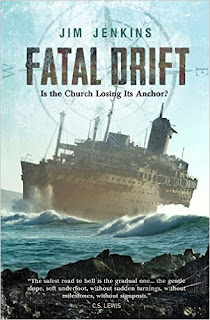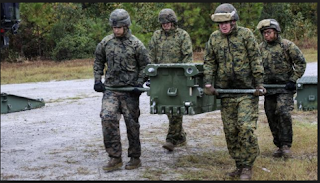A Book Review & Excerpt
Last Fall my husband and I sat down for coffee with Pastor Jim Jenkins. He had been introduced to us by two of our friends: Warren B. Smith, a well-known author whose writings have often appeared on Herescope, and Paul Smith, brother of the late Chuck Smith (Calvary Chapel) and author of New Evangelicalism: The New World Order. Pastor Jim wanted to give us a copy of his book, Fatal Drift: Is the Church Losing Its Anchor?
Pastor Jim told us how was one of the first-responders at 9/11, serving as a chaplain to the families amidst the toxic rubble and overwhelming human loss. I soon realized that his transformative life experience is similar to his book topic. In Fatal Drift: Is the Church Losing Its Anchor? Pastor Jim writes like a “first responder” coming upon the disastrous shipwreck of evangelical postmodernism. He explains, “In this book I will chronicle what I see as the abdicating of the church in the face of the barrage of progressive indoctrination.”(p. 29) Pastor Jim has a real heart for the Scripture, and he takes a strong
stand in his book for biblical inerrancy, which, he mentioned to us, was
rapidly degrading before his very eyes while he was getting his DMin at
Fuller.
Over coffee Pastor Jim told us about his jolting experience witnessing a high level New Age ceremony in British Columbia in 2012. He gives a detailed account of this disturbing incident in his book. After watching a “Sacred Circle Dance,” he reported that he “was stunned when she reached the point in her address where she, in a matter-of-fact fashion said, ‘All religions that are not harmonious with the New Age must be eliminated….’”(p. 19)[emphasis added]
In Fatal Drift: Is the Church Losing Its Anchor? Pastor Jim is a tour guide, leading the reader through the rubble and debris he stumbled onto while observing the rise of postmodern evangelicalism. He writes about the ramifications of the church abandoning biblical inerrancy and accommodating itself to the postmodern culture. He predicts, “In order to fuse progressive politics and progressive religion, the ‘troublesome’ passages which state that Christ is the only way of salvation in the Bible have to be dealt with,” and also the Gospel will be redefined “from salvation found in Christ alone to a kinder/gentler version….” (p. 29)
Pastor Jim also brings a fresh perspective to current issues in discerning the times. He is an encouragement to those of us who have served in the trenches of this for decades. His unique vantage point is from the heart of a pastor/chaplain who has arrived on the scene of the “great evangelical disaster” (Dr. Francis Schaeffer’s term) and seeks to warn others about it. He quotes from a wide range of commentators on the topic of postmodernism, explains how the church has been accommodating to the culture, and speaks to the necessity of holding to the position of biblical inerrancy. Note: some of the men cited in his book have fallen into errors. Nevertheless, a discerning reader should be able to navigate this.
Chapter 8 examining the postmodern use of narratives is worth the small price of the book. But first it requires knowing a working definition of the term postmodern. Pastor Jim has given us permission to reproduce a sample excerpt from his book from Chapter 5:
As I mentioned earlier, part of my Reserve Chaplain Career involved serving with the Marines. In that capacity while serving with a company of combat engineers which was tasked with building bridges, I learned a lesson I will never forget.
It was raining. It seemed like every drill weekend it was raining. This particular weekend we were camped out in a rock quarry along the river. Our assignment was to build a certain type of bridge to cross the river.
I had previously seen pallets of pre-engineered steel components stored at the Reserve Center. I noted at the time that I didn’t see cranes or other heavy equipment to the degree I might have expected. This weekend, I would learn why.
This particular type of bridge was designed to be assembled in pieces like a giant erector set, and it was designed to be assembled by manpower. Those pallets of bridge components also contained lifting bars. Two Marines or four Marines or how many as were needed would put on their gloves, pick up their lifting bars and literally lift each piece into position for assembly. It was backbreaking work... and did I mention it was raining?
A little background here might be instructive. The command structure of a Marine Reserve unit is comprised of both active duty and reserve components. Active duty Marines serve as instructors and facilitators and the reserve unit with its own commanding officer learns the skills necessary to function in a combat environment. The senior officer of the active duty component is known as the Inspector/Instructor or “I and I” for short.
This particular weekend, the Inspector/Instructor stood by relatively passively as the reserve officer took command and gave orders to begin the bridge building. This particular type of bridge is assembled on one river bank by hand…. It was raining; did I mention that?
Once the bridge superstructure was completed on one bank of the river, a boom component would be thrust across to the other side where the rest of the construction would take place. Once complete, the bridge would be sturdy enough to handle both people and vehicle traffic.
My job as chaplain was to be with the troops as they accomplished this arduous task, encouraging them, ripping open an MRE and sharing coffee with them on their break, being the comic relief as I attempted to do even a portion of the hard labor… all the while affirming them.
It really was inspiring to watch these young devil dogs as they strained to lift each piece of solid steel, and then bolt each plate piece in place. All day long as the rain came down, they counted and lifted in unison… piece by piece… knuckle busting… dirty… sandy… grubby hard work.
At the end of what seemed like three days instead of one. The pieces were all assembled. The commander gave the order, and the exhausted Marines prepared for one last herculean effort to thrust the boom across the river. “ONE… TWO…. THREE”… and they pushed with all their might… nothing.
Two… three times more… they redoubled their efforts… “PUSH!”… nothing. The officer in charge began to sweat…. Finally, the order came to ‘stand by’ and the Inspector/Instructor and the commander took a little walk.
I was close enough to overhear their conversation. To his credit, the active duty officer didn’t berate the officer in charge. As they looked off in the opposite direction together I overheard the Inspector Instructor say, “You eyeballed it didn’t you?”
Despite protestations to the contrary, the officer in charge admitted that perhaps at the very beginning of the exercise he may have just estimated or “eyeballed it” but the rest of the day, he consulted the book.
“You should have started by the book at the very beginning. All you did was add tons of weight to something that wasn’t in alignment from the start. You’ll have to do it all over.”
And so the Marines used every colorful word in their lexicon, grabbed some MRE’s and then put their gloves back on (Oh, and did I say it was raining?), took the whole thing apart bit by bit… piece by piece… and then started it all over again. Only this time it was by the book, from step one to the finish.
The Inspector/Instructor taught a powerful lesson. The officer in charge learned a powerful lesson, and a soggy chaplain learned perhaps the most powerful lesson of all. For you see the whole time I heard those two officers talking, I thought about the authority of the Bible, and the absolute necessity of living “by the Book.”
I was witnessing a parable. In preparing to write this book, I thought back to this rainy day bridge-building exercise. As church leaders, we can be well intentioned in our efforts to build a bridge to reach people for the Lord. We can exert incredible amounts of energy. We can even motivate others to redouble their efforts. We can have team building exercises—esprit d’ corps— if you will.
At the end of the day, however, if what we do, we attempt to do in our strength, we’ll end up doing what seems best to us (eyeballing it) rather than consulting our manual—the Bible. Our best bridge may look nice, but can’t help people safely reach the other side.
All the weighty improvisations, clever though they be, will not account for failing to consult the Book from the outset. Anything built on a less than God’s specified start point will eventually be immobilized by its own weight. Hence the purpose in writing this book.
Throughout my entire ministry, I have been watching and warning and preaching because I see something. There has been a steady, methodical, relentless assault on the authority of the Scriptures. The notion of an inerrant Bible and the very idea of such a thing as propositional truth are now looked upon as relics from an irrelevant past—ideas destined for the dust bin of history.
Emergent church writer Phyllis Tickle has actually said that every five hundred years or so the church needs to have a rummage sale (the inference being, “to throw out useless stuff” that no one wants anymore.) What is shocking to me is that she was referring to the doctrines of the Protestant Reformation, and the main doctrine known as Sola Scriptura . . . Only the Scriptures.1
We are obsessed with innovation. We hold conference after conference on how to build bridges to people… We write books and read books on “how to be relevant”… think about that for a minute…. The Church of the living God needing to consult ad men and social scientists in order to accommodate the world spirit… to be perceived as relevant?
I remember an incident that took place when George W. Bush was president. The press hounded him relentlessly, always probing, looking to trap him in a “Gotcha” moment.
One clever reporter cited a critic who inferred that the President was no longer relevant. President Bush took the bait and said. “I’m relevant.” Well guess what the press did with that sound bite? For months they played it over and over again. He had been tricked into giving weight to a question that was designed to put him on the defensive, and by answering he gave credibility to the assumption . . . a contrived assumption of his perceived irrelevance.
I believe that denominations, seminaries, and Christians in general have fallen prey to a similar ploy. Emergent church writers say the same thing again and again in one form or another. “In this postmodern era, none of the old ideas will work in reaching this generation.”
Once this premise is uttered, Christian pollsters oblige with survey after survey confirming the conventional wisdom that the church must totally revamp its methods and sadly alter its message to reach these special people who would never respond to something as “old school” as altar calls and preaching the certainty of Jesus Christ as the only savior.
What does the term postmodern mean anyway? I came across this insightful description of the term.
A general and wide-ranging term which is applied to literature, art, philosophy, architecture, fiction, and cultural and literary criticism, among others. Postmodernism is largely a reaction to the assumed certainty of scientific, or objective, efforts to explain reality. In essence, it stems from a recognition that reality is not simply mirrored in human understanding of it, but rather, is constructed as the mind tries to understand its own particular and personal reality.
For this reason, postmodernism is highly skeptical of explanations which claim to be valid for all groups, cultures, traditions, or races, and instead focuses on the relative truths of each person. In the postmodern understanding, interpretation is everything; reality only comes into being through our interpretations of what the world means to us individually. Postmodernism relies on concrete experience over abstract principles, knowing always that the outcome of one’s own experience will necessarily be fallible and relative, rather than certain and universal.2
From that definition I glean that postmodernism is:
- primarily a reaction
- that it constructs reality in the mind rather than relying on objective truth
- that reality only ‘comes into being’ in our interpretation
- that personal experience trumps objective propositional truth
Thinking about the implications of this for bridge building, I try to imagine a bridge being built based on these criteria. What would a bridge be like if it was built solely based on a reactionary approach which emphasized interpretation and downplayed proposition truths like the laws of physics?
One of the signs of a community in decline is a crumbling infrastructure. In the recent federal government stimulus package, which was supposed to kick start the economy, one of the first areas of investment was to be the repair of unsafe bridges. What makes for a safe, reliable bridge? For a bridge to be safe, it must be the product of both engineered plans and tested materials. And once built, bridges need to be inspected and maintained. Let’s look at each of these criteria….
Endnotes:
1. [The late] Phyllis Tickle’s book is entitled The Great Emergence: How
Christianity Is Changing and Why.
“Tickle’s basic thesis is that every 500 years, the Church goes through a
rummage sale, and cleans out the old forms of spirituality and replaces
it with new ones. This does not mean that previous forms become
obsolete or invalid. It simply means they lose pride of place as the
dominant form of Christianity. Constantine in the late 4th century,
early 5th, the Great Schism of the 11th century, the Reformation in the
16th century, and now the Postmodern era in the 21st century have all
been points of reference for these changes.
What is giving way right now is Protestantism, in the form that we know
it, and what is emerging is a new form of Christianity, what she is
calling “The Great Emergence.” One can only guess whether or not it is
tribal form, an individualistic form, a social form, or a combination of
all of them. But, what we can say is that Protestantism in all its
denominational forms is losing influence and is giving way to
alternative forms of Christian expression.”
http://vialogue.wordpress.com/2008/04/27/the-great-emergence-phyllis-tickles-500-year-rummage-sale/
2. PBS,
“Postmodern,” accessed December 15, 2012,
http://www.pbs.org/faithandreason/gengloss/postm-body.html
To read the rest of this chapter, see the book on Amazon: Fatal Drift: Is the Church Losing Its Anchor?






